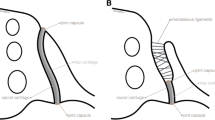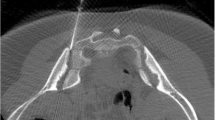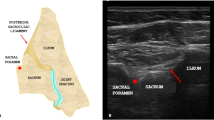Abstract
Objectives
To test the hypothesis that MR imaging guided triamcinolone acetonide injection into the sacroiliac joints of children with enthesitis-related arthritis is feasible, accurate and safe; and effectively reduces sacroiliac inflammation and disease progression.
Methods
A retrospective analysis of 14 children (6/14 [43%] female, 8/14 (57%) male; mean age, 13.2 years; range, 6–16 years) who received MR imaging guided sacroiliac joint injections at 0.2 Tesla or 1.5 Tesla for enthesitis-related arthritis and acute sacroilitis refractory to medical therapy was performed. 20 mg triamcinolone acetonide were injected. Assessed were intra-articular drug delivery; image quality, duration, and complications. Success of therapy was defined by change of sacroiliac inflammation. Remission time and erosions were assessed by follow-up MRI (range, 10–22 months).
Results
Twenty four procedures resulted in intra-articular injection. Image quality was sufficient. No complications occurred. Procedure time was 40 min. Sedation time was 22 min. Success of therapy was achieved in 11/14 (79%) children. Sacroiliac inflammation decreased significantly (−59%). Median remission time was 13.7 months. No erosions occurred.
Conclusions
MR imaging guided steroid injection of the sacroiliac joints is feasible, accurate, and safe and can effectively reduce sacroiliac inflammatory activity and may therefore aid in the prevention of disease progression.




Similar content being viewed by others
References
Azouz EM, Duffy CM (1995) Juvenile spondyloarthropathies: clinical manifestations and medical imaging. Skeletal Radiol 24:399–408
Hartman GH, Renaud DL, Sundaram M, Reed AM (2007) Spondyloarthropathy presenting at a young age: case report and review. Skeletal Radiol 36:161–164
Flato B, Hoffmann-Vold AM, Reiff A, Forre O, Lien G, Vinje O (2006) Long-term outcome and prognostic factors in enthesitis-related arthritis: a case-control study. Arthritis Rheum 54:3573–3582
Burgos-Vargas R (2002) The juvenile-onset spondyloarthritides. Rheum Dis Clin North Am 28:531–560, vi
Hashkes PJ, Laxer RM (2005) Medical treatment of juvenile idiopathic arthritis. JAMA 294:1671–1684
Hashkes PJ, Laxer RM (2006) Update on the medical treatment of juvenile idiopathic arthritis. Curr Rheumatol Rep 8:450–458
Bongartz T, Sutton AJ, Sweeting MJ, Buchan I, Matteson EL, Montori V (2006) Anti-TNF antibody therapy in rheumatoid arthritis and the risk of serious infections and malignancies: systematic review and meta-analysis of rare harmful effects in randomized controlled trials. JAMA 295:2275–2285
Breit W, Frosch M, Meyer U, Heinecke A, Ganser G (2000) A subgroup-specific evaluation of the efficacy of intraarticular triamcinolone hexacetonide in juvenile chronic arthritis. J Rheumatol 27:2696–2702
Balogh Z, Ruzsonyi E (1987) Triamcinolone hexacetonide versus betamethasone. A double-blind comparative study of the long-term effects of intra-articular steroids in patients with juvenile chronic arthritis. Scand J Rheumatol Suppl 67:80–82
Zulian F, Martini G, Gobber D, Plebani M, Zacchello F, Manners P (2004) Triamcinolone acetonide and hexacetonide intra-articular treatment of symmetrical joints in juvenile idiopathic arthritis: a double-blind trial. Rheumatology (Oxford) 43:1288–1291
Fischer T, Biedermann T, Hermann KG et al (2003) Sacroiliitis in children with spondyloarthropathy: therapeutic effect of CT-Guided intra-articular corticosteroid injection. Rofo 175:814–821
Fritz J, Clasen S, Boss A et al (2008) Real-time MR fluoroscopy-navigated lumbar facet joint injections: feasibility and technical properties. Eur Radiol 18:1513–1518
Fritz J, Henes JC, Thomas C et al (2008) Diagnostic and interventional MRI of the sacroiliac joints using a 1.5-T open-bore magnet: a one-stop-shopping approach. AJR Am J Roentgenol 191:1717–1724
Slovis TL (2002) The ALARA concept in pediatric CT: myth or reality? Radiology 223:5–6
Stattaus J, Maderwald S, Baba HA et al (2008) MR-guided liver biopsy within a short, wide-bore 1.5 Tesla MR system. Eur Radiol 18:2865–2873
Ricke J, Thormann M, Ludewig M et al (2010) MR-guided liver tumor ablation employing open high-field 1.0T MRI for image-guided brachytherapy. Eur Radiol 20:1985–1993
Kos S, Huegli R, Bongartz GM, Jacob AL, Bilecen D (2008) MR-guided endovascular interventions: a comprehensive review on techniques and applications. Eur Radiol 18:645–657
Konig CW, Schott UG, Pereira PL et al (2002) MR-guided lumbar sympathicolysis. Eur Radiol 12:1388–1393
Streitparth F, Walter T, Wonneberger U et al (2010) Image-guided spinal injection procedures in open high-field MRI with vertical field orientation: feasibility and technical features. Eur Radiol 20:395–403
Cahill AM, Cho SS, Baskin KM et al (2007) Benefit of fluoroscopically guided intraarticular, long-acting corticosteroid injection for subtalar arthritis in juvenile idiopathic arthritis. Pediatr Radiol 37:544–548
National Research Council (U.S.), Committee to Assess Health Risks from Exposure to Low Level of Ionizing Radiation (2006) Health risks from exposure to low levels of ionizing radiation: BEIR VII, Phase 2. National Academies Press, Washington, D.C
Fritz J, Niemeyer T, Clasen S et al (2007) Management of chronic low back pain: rationales, principles, and targets of imaging-guided spinal injections. Radiographics 27:1751–1771
Petty RE, Southwood TR, Manners P et al (2004) International League of Associations for Rheumatology classification of juvenile idiopathic arthritis: second revision, Edmonton, 2001. J Rheumatol 31:390–392
Lewin JS, Petersilge CA, Hatem SF et al (1998) Interactive MR imaging-guided biopsy and aspiration with a modified clinical C-arm system. AJR Am J Roentgenol 170:1593–1601
Hicks CL, von Baeyer CL, Spafford PA, van Korlaar I, Goodenough B (2001) The Faces Pain Scale-Revised: toward a common metric in pediatric pain measurement. Pain 93:173–183
Fritz J, Thomas C, Clasen S, Claussen CD, Lewin JS, Pereira PL (2009) Freehand real-time MRI-guided lumbar spinal injection procedures at 1.5 T: feasibility, accuracy, and safety. AJR Am J Roentgenol 192:W161–W167
Lewin JS, Duerk JL, Jain VR, Petersilge CA, Chao CP, Haaga JR (1996) Needle localization in MR-guided biopsy and aspiration: effects of field strength, sequence design, and magnetic field orientation. AJR Am J Roentgenol 166:1337–1345
Cleary AG, Murphy HD, Davidson JE (2003) Intra-articular corticosteroid injections in juvenile idiopathic arthritis. Arch Dis Child 88:192–196
Bollow M, Fischer T, Reisshauer H et al (2000) Quantitative analyses of sacroiliac biopsies in spondyloarthropathies: T cells and macrophages predominate in early and active sacroiliitis-cellularity correlates with the degree of enhancement detected by magnetic resonance imaging. Ann Rheum Dis 59:135–140
Wick MC, Weiss RJ, Jaschke W, Klauser AS (2010) Erosions are the most relevant magnetic resonance imaging features in quantification of sacroiliac joints in ankylosing spondylitis. J Rheumatol 37:622–627
Bollow M, Braun J, Taupitz M et al (1996) CT-guided intraarticular corticosteroid injection into the sacroiliac joints in patients with spondyloarthropathy: indication and follow-up with contrast-enhanced MRI. J Comput Assist Tomogr 20:512–521
Huppertz HI, Tschammler A, Horwitz AE, Schwab KO (1995) Intraarticular corticosteroids for chronic arthritis in children: efficacy and effects on cartilage and growth. J Pediatr 127:317–321
Author information
Authors and Affiliations
Corresponding author
Rights and permissions
About this article
Cite this article
Fritz, J., Tzaribachev, N., Thomas, C. et al. Evaluation of MR imaging guided steroid injection of the sacroiliac joints for the treatment of children with refractory enthesitis-related arthritis. Eur Radiol 21, 1050–1057 (2011). https://doi.org/10.1007/s00330-010-1994-1
Received:
Revised:
Accepted:
Published:
Issue Date:
DOI: https://doi.org/10.1007/s00330-010-1994-1




